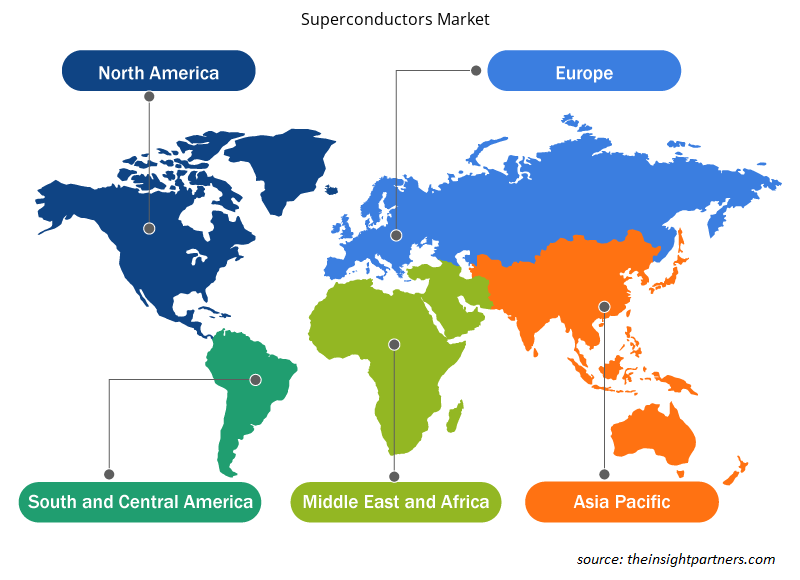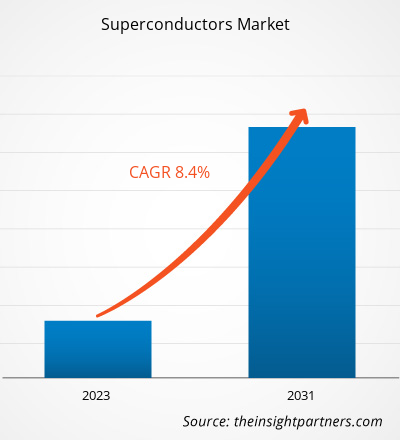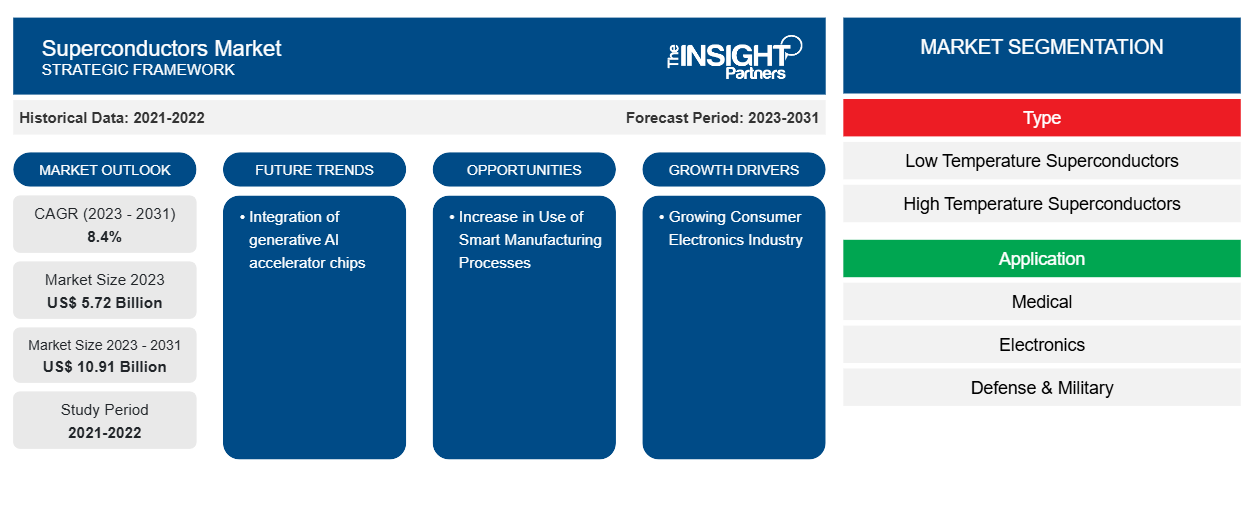Der Markt für Supraleiter soll von 5,72 Milliarden US-Dollar im Jahr 2023 auf 10,91 Milliarden US-Dollar im Jahr 2031 anwachsen. Der Markt wird zwischen 2023 und 2031 voraussichtlich eine durchschnittliche jährliche Wachstumsrate von 8,4 % verzeichnen. Die Integration generativer KI-Beschleunigerchips dürfte ein wichtiger Trend auf dem Markt bleiben.
Marktanalyse für Supraleiter
Supraleiter finden in der MRT-Technologie ein breites Anwendungsspektrum. Dieser technologische Trend wird sich voraussichtlich auch über den Prognosezeitraum hinaus fortsetzen, was darauf hindeutet, dass der Markt für supraleitende Materialien vielversprechend ist. Darüber hinaus ist einer der Hauptgründe für die Nachfrage nach Supraleitern der steigende Bedarf an hocheffizienten Elektromotoren . Diese Faktoren tragen weiter zum Wachstum der globalen Marktanalyse für Supraleiter bei.
Marktübersicht für Supraleiter
Der Begriff Supraleiter bezieht sich auf Materialien, die Elektrizität ohne Widerstand leiten. Sie können Strom über einen längeren Zeitraum ohne Energieverlust leiten. Kritisches Magnetfeld, Wärmekapazität, kritische Temperatur und kritische Stromdichte sind alles physikalische Parameter von supraleitenden Materialien. Je nach Art des supraleitenden Materials können diese Eigenschaften unterschiedlich sein. Eigenschaften wie der spezifische Widerstand werden jedoch nicht durch die Substanz beeinflusst. Die Medizinbranche hat sich durch die Einführung von Magnetresonanztomographiegeräten (MRT), die supraleitende Materialien verwenden, verändert. Weitere Branchen, die erheblich von Supraleitern profitiert haben, sind Transport, Militär, Elektronik und Energieversorgung.
Passen Sie diesen Bericht Ihren Anforderungen an
Sie erhalten kostenlos individuelle Anpassungen an jedem Bericht, einschließlich Teilen dieses Berichts oder einer Analyse auf Länderebene, eines Excel-Datenpakets sowie tolle Angebote und Rabatte für Start-ups und Universitäten.
-
Holen Sie sich die wichtigsten Markttrends aus diesem Bericht.Dieses KOSTENLOSE Beispiel umfasst eine Datenanalyse von Markttrends bis hin zu Schätzungen und Prognosen.
Treiber und Chancen auf dem Supraleitermarkt
Wachsende Unterhaltungselektronikbranche begünstigt Markt
Supraleiter sind wichtige Komponenten elektronischer Geräte und ermöglichen Fortschritte in den Bereichen Kommunikation, Computer, Gesundheitswesen, Militärsysteme, Transport, saubere Energie und eine Vielzahl anderer Anwendungen. Computer (+34 %) und Fernsehgeräte (+12 %) haben sich in den letzten drei Jahren international weitaus schneller verbreitet als Mobiltelefone (+1 %), was höchstwahrscheinlich auf die Einschränkungen durch COVID-19 und die zunehmende Zeit zurückzuführen ist, die mit Arbeiten und Lernen von zu Hause verbracht wird. Infolgedessen ist der Anteil der Smartphones am Gesamtumsatz der drei Gerätekategorien von 65 % auf 60 % gesunken. Mit der steigenden Nachfrage nach Unterhaltungselektronik wird erwartet, dass die Nachfrage nach Supraleitern in den kommenden Jahren steigen wird.
Zunehmender Einsatz intelligenter Fertigungsprozesse
Im Laufe der Jahre haben Supraleiter-Fertigungsanlagen und ausgelagerte Supraleiter-Test- und Montageanlagen (OSATs) IoT-Geräte, Robotertechnologie, künstliche Intelligenz/Maschinelles Lernen (KI/ML) und Analysen eingesetzt, um intelligente, vollautomatische Chipfabriken zu realisieren. Hersteller von Wafer-Fabrikausrüstung, Hersteller integrierter Geräte (IDMs), Gießereien und Back-End-Montage- und Testanlagen (AT) erhöhen allesamt ihre Investitionen in intelligente Fertigungsmethoden, digitale Werkzeuge und Technologien.OSATs) have used IoT devices, robotics technology, artificial intelligence/machine learning (AI/ML), and analytics to achieve smart, lights-out chip factories that are completely automated. Wafer fab equipment manufacturers, integrated device manufacturers (IDMs), foundries, and back-end assembly and test (AT) facilities are all increasing their investments in smart manufacturing methods, digital tools, and technologies.
Segmentierungsanalyse des Marktberichts für Supraleiter
Wichtige Segmente, die zur Ableitung der Marktanalyse für Supraleiter beigetragen haben, sind Typ und Anwendung.
- Basierend auf dem Typ ist der Markt in Niedertemperatur-Supraleiter und Hochtemperatur-Supraleiter segmentiert. Das Segment der Niedertemperatur-Supraleiter hatte im Jahr 2023 einen bedeutenden Marktanteil.
- Basierend auf der Anwendung ist der Markt in Medizin, Elektronik, Verteidigung und Militär und andere segmentiert. Das Elektroniksegment hielt im Jahr 2023 den größten Marktanteil.
Supraleiter Marktanteilsanalyse nach Geografie
Der geografische Umfang des Marktberichts für Supraleiter ist hauptsächlich in fünf Regionen unterteilt: Nordamerika, Asien-Pazifik, Europa, Naher Osten und Afrika sowie Süd- und Mittelamerika.
Nordamerika dominierte den Markt im Jahr 2023. Nordamerika ist in der Medizin- und Verteidigungsindustrie stetig gewachsen. Die Region hat einen deutlichen Anstieg der Investitionen in die medizinische Infrastruktur und der Beschaffung medizinischer Geräte für diese Infrastrukturen erlebt. Daher wird erwartet, dass die steigende Nachfrage nach Magnetresonanztomographiegeräten (MRT) in der gesamten Region die Nachfrage nach Supraleitern bei den Herstellern medizinischer Geräte direkt beeinflussen wird. Darüber hinaus haben Länder wie die USA und Kanada in den letzten fünf Jahren einen Anstieg der Militärausgaben erlebt , was die Nachfrage nach Power Railguns und Coil Guns beeinflusst. Rüstungshersteller setzen in großem Umfang Supraleiter ein, um die Widerstandsfähigkeit und Effizienz von Waffen zu erhöhen. Daher wird erwartet, dass die steigende Nachfrage nach Power Railguns und Coil Guns in der gesamten Region weiter zum Wachstum des nordamerikanischen Supraleitermarktes beiträgt.railguns and coil guns. Defense manufacturers are highly adopting superconductors to increase the resistance and efficiency of weapons. Thus, the rise in demand for power railguns and coil guns across the region is further expected to contribute to the North American superconductors market growth.
Regionale Einblicke in den Supraleitermarkt
Die regionalen Trends und Faktoren, die den Supraleitermarkt während des Prognosezeitraums beeinflussen, wurden von den Analysten von Insight Partners ausführlich erläutert. In diesem Abschnitt werden auch die Marktsegmente und die Geografie des Supraleitermarkts in Nordamerika, Europa, im asiatisch-pazifischen Raum, im Nahen Osten und Afrika sowie in Süd- und Mittelamerika erörtert.

- Holen Sie sich die regionalspezifischen Daten für den Supraleitermarkt
Umfang des Marktberichts zu Supraleitern
| Berichtsattribut | Details |
|---|---|
| Marktgröße im Jahr 2023 | 5,72 Milliarden US-Dollar |
| Marktgröße bis 2031 | 10,91 Milliarden US-Dollar |
| Globale CAGR (2023 - 2031) | 8,4 % |
| Historische Daten | 2021-2022 |
| Prognosezeitraum | 2023–2031 |
| Abgedeckte Segmente |
Nach Typ
|
| Abgedeckte Regionen und Länder |
Nordamerika
|
| Marktführer und wichtige Unternehmensprofile |
|
Marktdichte von Supraleitern: Auswirkungen auf die Geschäftsdynamik verstehen
Der Markt für Supraleiter wächst rasant, angetrieben durch die steigende Nachfrage der Endverbraucher aufgrund von Faktoren wie sich entwickelnden Verbraucherpräferenzen, technologischen Fortschritten und einem größeren Bewusstsein für die Vorteile des Produkts. Mit steigender Nachfrage erweitern Unternehmen ihr Angebot, entwickeln Innovationen, um die Bedürfnisse der Verbraucher zu erfüllen, und nutzen neue Trends, was das Marktwachstum weiter ankurbelt.
Die Marktteilnehmerdichte bezieht sich auf die Verteilung der Firmen oder Unternehmen, die in einem bestimmten Markt oder einer bestimmten Branche tätig sind. Sie gibt an, wie viele Wettbewerber (Marktteilnehmer) in einem bestimmten Marktraum im Verhältnis zu seiner Größe oder seinem gesamten Marktwert präsent sind.
Die wichtigsten auf dem Supraleitermarkt tätigen Unternehmen sind:
- Amerikanische Superconductor Corporation
- Bruker Corporation
- Furukawa Electric Co. Ltd.
- Hitachi Ltd.
- Hyoer Tech Research, Inc.
- Japan Superconductor Technology, Inc.
Haftungsausschluss : Die oben aufgeführten Unternehmen sind nicht in einer bestimmten Reihenfolge aufgeführt.

- Überblick über die wichtigsten Akteure auf dem Markt für Supraleiter
Neuigkeiten und aktuelle Entwicklungen zum Supraleitermarkt
Der Supraleitermarkt wird durch die Erhebung qualitativer und quantitativer Daten aus Primär- und Sekundärforschung bewertet, die wichtige Unternehmensveröffentlichungen, Verbandsdaten und Datenbanken einschließen. Nachfolgend sind einige der Entwicklungen auf dem Supraleitermarkt aufgeführt:
- Bruker Corporation, der führende Anbieter von Kernspinresonanzsystemen (NMR), kündigte neuartige Magnettechnologie und Analyselösungen an, um die breite Einführung von NMR in der akademischen Grundlagen- und klinischen Forschung sowie in der Arzneimittelentdeckung, -entwicklung und Prozessanalysetechnologien (PAT) in der Biopharmazie zu unterstützen. (Quelle: Bruker Corporation, Pressemitteilung, April 2024)
- Tokamak Energy hat mit führenden japanischen und US-amerikanischen Unternehmen eine Vereinbarung zur Lieferung von speziellem Hochtemperatur-Supraleiterband (HTS) für seinen neuen fortschrittlichen Prototyp einer Fusionsanlage, ST80-HTS, unterzeichnet. Furukawa Electric Co., Ltd., Tokio, Japan, und SuperPower Inc., New York, USA, von der Furukawa Electric Group, werden dem in Oxford ansässigen Unternehmen für die nächste Bauphase voraussichtlich mehrere hundert Kilometer Band liefern. (Quelle: Furukawa Electric Co., Ltd., Pressemitteilung, Januar 2023)
Marktbericht zu Supraleitern: Abdeckung und Ergebnisse
Der Bericht „Marktgröße und Prognose für Supraleiter (2021–2031)“ bietet eine detaillierte Analyse des Marktes, die die folgenden Bereiche abdeckt:
- Marktgröße und Prognose für Supraleiter auf globaler, regionaler und Länderebene für alle wichtigen Marktsegmente, die im Rahmen des Berichts abgedeckt sind
- Markttrends und Marktdynamiken für Supraleiter wie Treiber, Hemmnisse und wichtige Chancen
- Detaillierte PEST/Porters Five Forces- und SWOT-Analyse
- Marktanalyse für Supraleiter mit wichtigen Markttrends, globalen und regionalen Rahmenbedingungen, wichtigen Akteuren, Vorschriften und aktuellen Marktentwicklungen
- Branchenlandschaft und Wettbewerbsanalyse, einschließlich Marktkonzentration, Heatmap-Analyse, prominenten Akteuren und aktuellen Entwicklungen für den Supraleitermarkt
- Detaillierte Firmenprofile
- Historische Analyse (2 Jahre), Basisjahr, Prognose (7 Jahre) mit CAGR
- PEST- und SWOT-Analyse
- Marktgröße Wert/Volumen – Global, Regional, Land
- Branchen- und Wettbewerbslandschaft
- Excel-Datensatz
Aktuelle Berichte
Erfahrungsberichte
Grund zum Kauf
- Fundierte Entscheidungsfindung
- Marktdynamik verstehen
- Wettbewerbsanalyse
- Kundeneinblicke
- Marktprognosen
- Risikominimierung
- Strategische Planung
- Investitionsbegründung
- Identifizierung neuer Märkte
- Verbesserung von Marketingstrategien
- Steigerung der Betriebseffizienz
- Anpassung an regulatorische Trends























 Kostenlose Probe anfordern für - Markt für Supraleiter
Kostenlose Probe anfordern für - Markt für Supraleiter